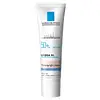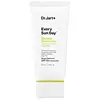What's inside
What's inside
 Key Ingredients
Key Ingredients

 Benefits
Benefits

 Concerns
Concerns

 Ingredients Side-by-side
Ingredients Side-by-side

Water
Skin ConditioningEthylhexyl Methoxycinnamate
UV AbsorberSqualene
EmollientTitanium Dioxide
Cosmetic ColorantGlycerin
HumectantDrometrizole Trisiloxane
UV AbsorberTerephthalylidene Dicamphor Sulfonic Acid
UV AbsorberPropylene Glycol
HumectantAlcohol Denat.
AntimicrobialTriethanolamine
BufferingDipropylene Glycol
HumectantMica
Cosmetic ColorantStearic Acid
CleansingPotassium Cetyl Phosphate
EmulsifyingTocopherol
AntioxidantNylon-12
Acrylamide/Sodium Acryloyldimethyltaurate Copolymer
Emulsion StabilisingAluminum Hydroxide
EmollientCI 77120
Cosmetic ColorantBHT
AntioxidantBis-Ethylhexyloxyphenol Methoxyphenyl Triazine
Skin ConditioningButylene Glycol
HumectantButyrospermum Parkii Butter
Skin ConditioningHydrolyzed Shea Seedcake Extract
Skin ConditioningCaprylyl Glycol
EmollientCarbomer
Emulsion StabilisingCetyl Alcohol
EmollientCI 77491
Cosmetic ColorantCI 77492
Cosmetic ColorantIron Oxides
CI 77891
Cosmetic ColorantDiethylamino Hydroxybenzoyl Hexyl Benzoate
UV FilterEthylhexyl Triazone
UV AbsorberGlyceryl Stearate
EmollientIsohexadecane
EmollientMyristic Acid
CleansingPaeonia Suffruticosa Root Extract
Skin ProtectingPalmitic Acid
EmollientPEG-100 Stearate
Phenoxyethanol
PreservativePolysorbate 80
EmulsifyingPotassium Sorbate
PreservativeSodium Chloride
MaskingSodium Cocoyl Sarcosinate
CleansingSorbitan Oleate
EmulsifyingThermus Thermophillus Ferment
Skin ConditioningTrisodium Ethylenediamine Disuccinate
Tromethamine
BufferingXanthan Gum
EmulsifyingWater, Ethylhexyl Methoxycinnamate, Squalene, Titanium Dioxide, Glycerin, Drometrizole Trisiloxane, Terephthalylidene Dicamphor Sulfonic Acid, Propylene Glycol, Alcohol Denat., Triethanolamine, Dipropylene Glycol, Mica, Stearic Acid, Potassium Cetyl Phosphate, Tocopherol, Nylon-12, Acrylamide/Sodium Acryloyldimethyltaurate Copolymer, Aluminum Hydroxide, CI 77120, BHT, Bis-Ethylhexyloxyphenol Methoxyphenyl Triazine, Butylene Glycol, Butyrospermum Parkii Butter, Hydrolyzed Shea Seedcake Extract, Caprylyl Glycol, Carbomer, Cetyl Alcohol, CI 77491, CI 77492, Iron Oxides, CI 77891, Diethylamino Hydroxybenzoyl Hexyl Benzoate, Ethylhexyl Triazone, Glyceryl Stearate, Isohexadecane, Myristic Acid, Paeonia Suffruticosa Root Extract, Palmitic Acid, PEG-100 Stearate, Phenoxyethanol, Polysorbate 80, Potassium Sorbate, Sodium Chloride, Sodium Cocoyl Sarcosinate, Sorbitan Oleate, Thermus Thermophillus Ferment, Trisodium Ethylenediamine Disuccinate, Tromethamine, Xanthan Gum
Water
Skin ConditioningCyclopentasiloxane
EmollientZinc Oxide
Cosmetic ColorantPropanediol
SolventTitanium Dioxide
Cosmetic ColorantButylene Glycol Dicaprylate/Dicaprate
EmollientLauryl Polyglyceryl-3 Polydimethylsiloxyethyl Dimethicone
Skin ConditioningMethyl Methacrylate Crosspolymer
Butyloctyl Salicylate
Skin ConditioningCaprylyl Methicone
Skin ConditioningCitrus Aurantium Dulcis Oil
MaskingCitrus Nobilis Peel Oil
MaskingLitsea Cubeba Fruit Oil
Masking1,2-Hexanediol
Skin ConditioningDisteardimonium Hectorite
StabilisingMagnesium Sulfate
Stearic Acid
CleansingAluminum Hydroxide
EmollientPolyglyceryl-3 Polydimethylsiloxyethyl Dimethicone
Skin ConditioningTriethoxycaprylylsilane
Sorbitan Caprylate
EmulsifyingGlyceryl Caprylate
EmollientEthylhexylglycerin
Skin ConditioningTocopherol
AntioxidantWater, Cyclopentasiloxane, Zinc Oxide, Propanediol, Titanium Dioxide, Butylene Glycol Dicaprylate/Dicaprate, Lauryl Polyglyceryl-3 Polydimethylsiloxyethyl Dimethicone, Methyl Methacrylate Crosspolymer, Butyloctyl Salicylate, Caprylyl Methicone, Citrus Aurantium Dulcis Oil, Citrus Nobilis Peel Oil, Litsea Cubeba Fruit Oil, 1,2-Hexanediol, Disteardimonium Hectorite, Magnesium Sulfate, Stearic Acid, Aluminum Hydroxide, Polyglyceryl-3 Polydimethylsiloxyethyl Dimethicone, Triethoxycaprylylsilane, Sorbitan Caprylate, Glyceryl Caprylate, Ethylhexylglycerin, Tocopherol
Ingredients Explained
These ingredients are found in both products.
Ingredients higher up in an ingredient list are typically present in a larger amount.
Aluminum Hydroxide is a form of aluminum. It can be naturally found in nature as the mineral gibbsite. In cosmetics, Aluminum Hydroxide is used as a colorant, pH adjuster, and absorbent.
As a colorant, Aluminum Hydroxide may add opacity, or reduce the transparency. Aluminum hydroxide is contains both basic and acidic properties.
According to manufacturers, this ingredient is an emollient and humectant. This means it helps hydrate the skin.
In medicine, this ingredient is used to help relieve heartburn and help heal ulcers.
There is currently no credible scientific evidence linking aluminum hydroxide in cosmetics to increased cancer risk.
Major health organizations allow the use of aluminum hydroxide in personal care products and have not flagged it as a carcinogenic risk at typical usage levels.
Learn more about Aluminum HydroxideStearic Acid is a fatty acid. It is an emollient, emulsifier, and texture enhancer.
As an emollient, stearic acid helps soften skin. It aids the skin's protective barrier by preventing water loss. It also provides a gentle cleansing effect without stripping away natural oils.
Stearic acid may also be used to enhance the texture of products. It can add volume and stabilize ingredients such as water and oil. This can help water and oil ingredients from separating.
Sources of stearic acid include animal or vegetable fats/oils such as coconut or shea. It can be naturally found in butter, cocoa butter, shea butter, vegetable fats, and animal tallow.
This ingredient may not be Malassezia folliculitis, or fungal-acne safe.
Learn more about Stearic AcidTitanium dioxide is a mineral UV filter widely used in sunscreens and cosmetics.
It is one of only two UV filters officially classified as “mineral” by regulatory agencies, the other being zinc oxide.
Titanium dioxide provides broad-spectrum protection mostly in the UVB and UVAII range, with some protection in the UVAI range.
While its UVA protection isn’t as strong as zinc oxide’s, the difference is minor.
A common myth is that mineral UV filters reflect UV light. However, modern research shows titanium dioxide absorbs UV radiation like chemical filters (~95% absorption & 5% reflection).
Thanks to its non-irritating nature, titanium dioxide is suitable for sensitive, acne-prone, or redness-prone skin. It is unlikely to cause "eye sting" like other sunscreen ingredients.
A major drawback of this ingredient is its white cast and thick texture. This is why mineral sunscreens often leave a white cast and are less cosmetically elegant than chemical/hybrid sunscreens.
To improve white cast and spreadability, micronized or nano-sized titanium dioxide is often used.
There are ongoing concerns surrounding nano-titanium oxide's impact on marine ecosystems.
There is no conclusive evidence that any form of titanium oxide (or any other sunscreen ingredients) will cause harm to marine ecosystems or coral reefs. The science is still developing but many consumers are keeping a close eye on this issue.
Please note, many destinations have reef-safety sunscreen rules. For instance, the U.S. Virgin Islands advises all visitors to use non-nano mineral sunscreens.
Nano mineral sunscreens once raised safety concerns about absorption into skin.
Extensive research has shown that they do not penetrate healthy or damaged skin; they remain safely on the surface and the top layer of dead skin (stratum corneum).
You'll likely find titanium dioxide bundled with alumina, silica, or dimethicone. These ingredients help make titanium dioxide highly photostable; this prevents it from interacting with other formula components under UV light.
Learn more about Titanium DioxideTocopherol (also known as Vitamin E) is a common antioxidant used to help protect the skin from free-radicals and strengthen the skin barrier. It's also fat soluble - this means our skin is great at absorbing it.
Vitamin E also helps keep your natural skin lipids healthy. Your lipid skin barrier naturally consists of lipids, ceramides, and fatty acids. Vitamin E offers extra protection for your skin’s lipid barrier, keeping your skin healthy and nourished.
Another benefit is a bit of UV protection. Vitamin E helps reduce the damage caused by UVB rays. (It should not replace your sunscreen). Combining it with Vitamin C can decrease sunburned cells and hyperpigmentation after UV exposure.
You might have noticed Vitamin E + C often paired together. This is because it is great at stabilizing Vitamin C. Using the two together helps increase the effectiveness of both ingredients.
There are often claims that Vitamin E can reduce/prevent scarring, but these claims haven't been confirmed by scientific research.
Learn more about TocopherolWater. It's the most common cosmetic ingredient of all. You'll usually see it at the top of ingredient lists, meaning that it makes up the largest part of the product.
So why is it so popular? Water most often acts as a solvent - this means that it helps dissolve other ingredients into the formulation.
You'll also recognize water as that liquid we all need to stay alive. If you see this, drink a glass of water. Stay hydrated!
Learn more about Water